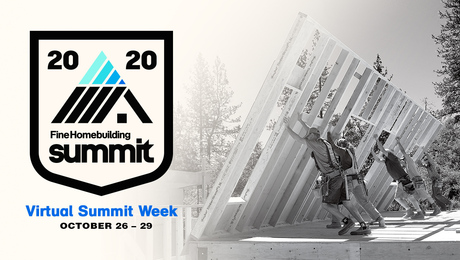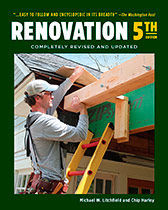Podcast 293: Staying Profitable, Extension Jambs, and Smoke That Don’t Stink
Matt, Rob, and Patrick hear from listeners about a garage-shop project completed in the nick of time and staying healthy when working construction before taking listener questions about burning through profit at the end of a job, using replacement windows in a new build, and stink-free smoke for tracking down air leaks.
Follow the Fine Homebuilding Podcast on your favorite app. Subscribe now and don’t miss an episode:
 |
 |
Help us make better episodes and enter for a chance to win an FHB Podcast T-shirt:
www.finehomebuilding.com/podcastsurvey
Andrew writes in with an update on his new workshop and family members. Paul describes a likely reason an energy audit doesn’t include a blower-door test. Andy has some thoughts on staying healthy while working in residential construction. Barbara explains how she conquered Dorian’s Corian. Dave asks how to keep profits from evaporating at the end of a job. Jim wants to know if he can use replacement windows from an architectural salvage store in his new shed build. Roger asks how to extend window jambs when he switches from paneling to drywall, and Jim is looking for a source of smoke that doesn’t stink for tracking air leaks.
Editor Updates:
- Matt’s dogs
- Rob’s kitchen faucet
- Jeff’s spare dishwasher
- Patrick’s smokey mower
 |
 |
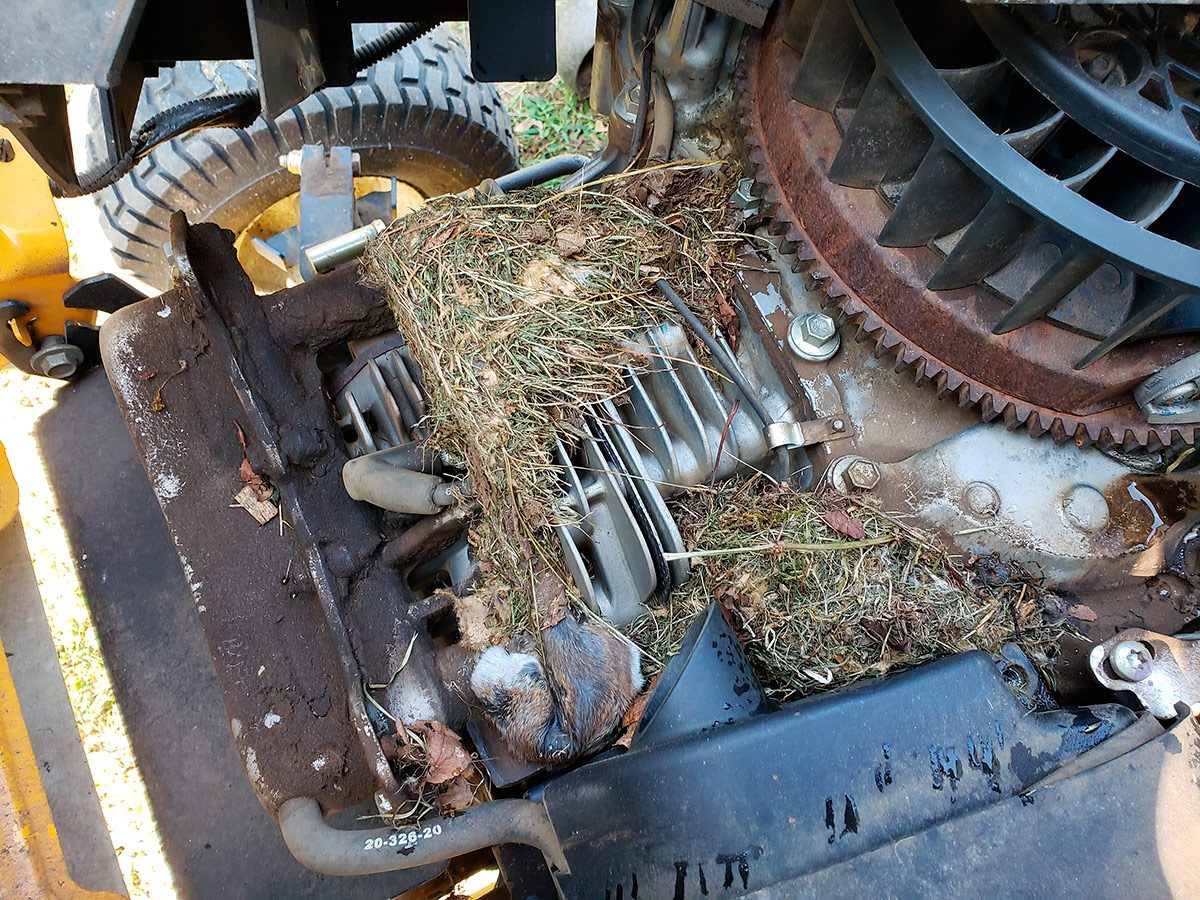 |
Related Links:
Listener Feedback 1:
Andrew in Chagrin Falls, OH writes: Howdy FHB crew – I want to thank you for your feedback on my detached garage insulation project back in episode 192. What I learned from you enabled me to simplify my approach and put together a functional workspace before my twin boys were born this June!
Frankly, you also saved me a pile of money I might have wasted chasing unreasonable, unnecessary performance characteristics for a woodshop with a leaky rollup door, 2×6 rafters, and a flat roof. I ended up getting the walls and ceiling sprayed with a flash coat of closed cell foam to help keep the drafts out, filled the cavities with cheap faced fiberglass batts, and covered the walls and ceiling with plywood. It might not be perfectly cozy during our Cleveland winters but it will be comfortable enough to enjoy making sawdust.
I’ve attached a couple photos. I’d never bent EMT before if you were curious as to why it looks like a drunken metallic spider had its way with my walls.
Keep craft alive,
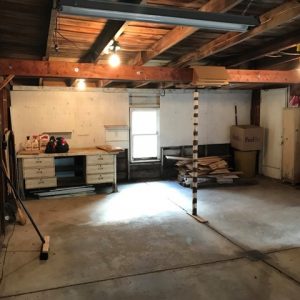 |
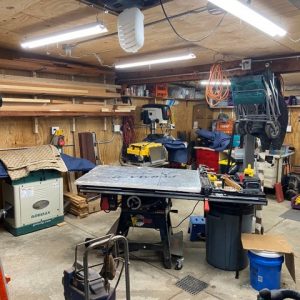 |
 |
Listener Feedback 2:
Paul writes: Hey Patrick and crew, After your listener question in episode 281 about blower door testing for energy audits, I nearly pulled my car to the side of the highway to defend my fellow Massachusetts energy auditors and weatherization professionals.
I suspect the reason why both the auditor and weatherization crew didn’t blower door test a house with a boiler has nothing to do with their company ethics, and everything to do with the Massachusetts utility funded weatherization program (aka Mass Save) and the extremely risk averse administrators who run the program.
As someone who used to be an auditor in the program (I’m now a HERS eater for new construction) I am familiar with the sometime arbitrary restraints that the program levied. This included things like conducting combustion safety tests in houses with all electric appliances, or not being able to air seal houses with a solid rock ledge in the basement for fear of lack of vapor control. Some of their risk aversion is also related to economic payback as well. Spray foam insulation and window replacement is heavily discouraged in the Mass Save program due to the longer payback periods as well as foams potential air quality and fire risk.
I think Mass Save’s choice to prohibit blower door tests in houses with steam boilers is borderline. It could be confirmed that there is no actual asbestos wrap in accessible basements and crawl spaces, but there is the possibility of friable asbestos in a wall cavity that could be pulled into the living space.
Even without a blower door test, a good energy auditor should still be able to diagnose most air sealing issues using their training and intuition, and perhaps an IR camera. With or without a blower door test, we know that air sealing is most crucial in the basement around the rim joist, and attic penetrations, including top plates. Those measure get spec’d in virtually every home, and the upside is that the homeowner pays nothing for it (on the front end anyways, the utilities get their share from your utility bills). Mass Save tends to avoid paying for air sealing baseboards and window trim, and would prefer people get dense packed cellulose, which has the ability to reduce air movement in those same areas while also adding insulation.
A lot of people have complaints about the Mass Save program, but ultimately, I’ll come to its defense, because it has consistently ranked as the best energy efficiency program year after year by the American Council for an Energy Efficient Economy
Thanks for making such a great show, and hopefully my next letter won’t be so reactionary.
Related Links:
- www.dsireusa.org – Database of State Incentives for Renewables & Efficiency
- Mass Save – Home Energy Assessment
Listener Feedback 3:
Andy in North Carolina writes: Hi Gang, I have recently been catching up on a backlog of FHB podcasts and have noticed a recurring theme in both podcast offerings. How to work in the construction field and avoid injuries or how to make it safer.
Most recently I have been transitioning from a construction management roll with an employer back into my own remodeling and new construction firm. This also comes at a time while I am learning to work alone or with little help while recovering from a shoulder surgery. The surgery was a result of a mountain biking accident years ago that left me with a plate and several screws in my collar bone. This repair removed the hardware and fixed some other damage in the joint which I suspect was caused by returning to the job too quickly after the initial injury.
During this process there are a few things I’ve learned that I wish I knew or valued when I was younger. I don’t claim to be an expert in this and at 38 feel like I have more aches and pains than I should which gives me some street cred I think.
- Live a healthy lifestyle outside of work, eat a decent diet, do some sort of exercise like jogging, cycling, swimming, yoga. Something low impact that makes you feel good. Most of the older trades people I know are all very active and able to continue to work well into their 60s.
- Invest in equipment that makes your work easier and safer such as forklifts, material lifts, cherry pickers ect. If you can’t afford to own one rent it and build it into the cost of the job.
- Wear the dang PPE, safety glasses, hearing protection, respirators, and fall protection. Just do it and stop acting like you’re a tough guy.
- Be nice to people, don’t force someone working for you to do something they aren’t comfortable with. If the new guy is afraid of heights don’t force them to go up the ladder.
- Learn about simple machines and how to use them in your work(now there is a good article topic)
- KEEP A CLEAN JOBSITE
While going through this 6 month recovery process and trying to figure out how to work again I’ve found that following those ideas has led me to be more efficient and thus more profitable.
I started in the trade as a laborer/clean up guy for a builder when I got laid off from my job writing ad copy for memory foam mattresses (that will put you to sleep faster than the mattresses). Back in my early 20s I felt invincible as we all did, the builder I worked for didn’t take safety very seriously. We were in the mountains of NC so there were lots of steep lots with sketchy ladders and scaffolding set up in ways I’m embarrassed to admit. Back then the motto was “if you fall you’re fired before you hit the ground”. Suffice it to say I don’t run my job sites that way nor will I. Thanks for the great podcast and hours of entertainment! Keep craft, craftsmen and craftswomen alive!
Listener Feedback 4: Dorian’s Corian update
Barbara writes: Hello FHB crew,
Here’s the video of how an oscillating multitool doesn’t work to remove a sink. I kept this one good and short and there’s no cussin’.
I mentioned in it that I sent a letter to you pondering the advisability of using the tool. And then I credited Matt for recommending the tool that actually worked. It was too sunny to wear your dark color shirt though, so I wore my own merch. Always be plugging! —Barbara
Related links:
Get the Most From Your Multitool
Question 1: How can you keep the tasks at the end of a construction project from cutting into your profit margin ?
Dave from Easton, Maryland writes, I am a senior project manager at Paquin Design Build in Grasonville, MD. I have been struggling this past year with the time, energy and expense it takes to bring a custom new build and remodel to completion. Specifically, the last 10% of the job. I see profits drastically descend in the last weeks of a project. So much so, I believe a job’s profitability somewhat hinges on the last 10% of the job. I really want to tackle developing a new paradigm for bringing a job to the finish line. BUT do not want to reinvent the wheel-meaning I am sure your readers have already tackled this issue. Before I move ahead, I wanted to check if Fine Homebuilding has ever tackled this issue, and if not, would you be open to making it the theme of a future issue? Any feedback and or direction would be greatly appreciated.
Related links:
Question 2: This comes from Jim Collins, a landscape architect in Burlington, Ontario. Jim was on Pro Talk in episode 282.
Jim writes, Hi FHB crew, I have a question for your crew in order to finish out my shed. The shed is 2×4 stud construction on concrete slab, with 2×6 roof rafters, asphalt shingles, and is clad with LP Smartside panels. These are a common product here for shed construction – and since this shed was a demo-shift-rebuild with LP smartside panels, I used the same when rebuilding it.
My question relates to a window installation. I would like to fit in a used vinyl insert window from the Habitat for Humanities Re-store (do you have these in the US?) that has no nailing flanges. Since the LP Smartside panels are not just siding but also the shear strength resistant cladding – how would you recommend cutting in this window?
 |
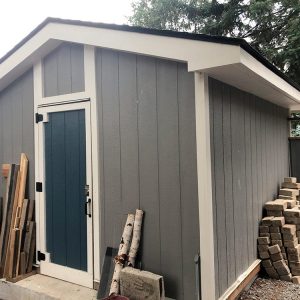 |
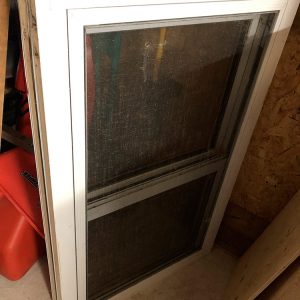 |
I was thinking to build a sill with some PVC or composite type material, and would like to trim around the window with 5/4 material like my doors and corners. Flashing? Caulking? or don’t stress since I have a 1ft overhang on that side?
Here’s a video link of the build project and some pictures of the window and shed exterior as well.
Thanks again for the awesome privilege of being on the ProTalk podcast. I would gladly join your team anytime if other landscape questions come up that I can assist with.
Related Links:
Question 3: Is there an easy alternative to installing extension jamb if your windows are slightly recessed into the wall?
Roger in Charleston, SC writes, Ahoy Podcast Team, I have been listening to the podcast since the beginning and am a big fan of both it and the magazine. I am remodeling a 1970’s ranch, and opening up the floorplan. This not my first project and am hoping to further hone my skills in construction and project management on this project so I can get a remodeling business moving before I retire from my second career.
This house, like many of its kind, was a very low budget build and has paneling instead of drywall on the walls. My question) is what are the options for trimming the windows when I remove the paneling and install drywall. It seems like a TON of work installing a half inch jam extension and prepping for paint but I don’t see any other way out.
Now, on the topic of becoming a skilled tradesperson, I think you can look no further the US Navy’s Construction Battalion They train seemingly every trade to build an airport so I would imagine those skills transfer to residential construction. Sure, not everyone wants to leave home and take on a military, see the world experience, but I have known several who did and are much better people for it.
I think all five branches of the armed services have some sort of solid/proven trade-specific training. This type of experience, when combined with a proven work ethic and and abundance of flexibility should make these people highly valuable in the civilian world. I can personally vouch for the Navy SeaBees after working with them during my Coast Guard days. I have added a couple links from youtube with more information about the SeaBees.
Thanks in advance for your help and let Brian know if he needs any volunteer help with Keeping Craft Alive here in Charleston please let know.
Related Link:
- Video Series: How to Install Interior Extension Jambs and Window Trim
- Navy Construction Battalion
- Base Construction in Antarctic
Question 4: What’s the most affordable option for smoke pens used for finding air leaks in your home?
Jim writes, You’ve spoken many times about using smoke to check for air leaks but all I can find when I look for “smoke pencils, etc.” is stuff that costs $40 and up for a kit. Is there a cheaper method for generating smoke that doesn’t stink (no incense, no cigarettes)?
Related Link:
- How to Set Up and Use a Blower Door
- How to Air-Seal an Attic
- Smoke Gets In Your Eyes
- Tiny Bubbles
- Candle in the Wind
END NOTE:
Visit the Taunton Store • Magazine Index • Online Archive • Our First Issues • All Access
Help us make better episodes and enter for a chance to win an FHB Podcast T-shirt: www.finehomebuilding.com/podcastsurvey
If you have any questions you would like us to dig into for a future show, shoot an email our way: fhbpodcast@taunton.com.
If we use your question we’ll send you a FHB Podcast sticker!
FHB Podcast T-shirts!
Represent your favorite podcast! Available in several styles and colors. Made from 100% cotton. Find the Podcast t-shirt and more cool products in the Fine Homebuilding Store.
This episode of the Fine Homebuilding podcast is brought to you by BuildBook.
Happy Clients. More Profits. Less Stress. That’s the trifecta of the construction business. We all want that, right? Well, after working and talking with 100’s of home builders and remodelers over the past 2 years, BuildBook has discovered the one common ingredient that determines the success of your construction business…the client experience.
Yes, if you drop the ball anywhere in the client experience from the first impression to the final payment, things can get super messy super quickly.
BuildBook has spent the past several months developing the first-of-its-kind platform that focuses on helping you deliver throughout the client journey the one thing standing between you and achieving the trifecta of construction.
It starts with marketing tools to attract the right leads. Add in sales tools so you can win the best projects. And finish with project tools that knock your clients socks off!
If you’re looking for an unfair advantage in your business, this is it. Head on over to BuildBook.co now to try it free for yourself.
Visit BuildBook.co for more.
Fine Homebuilding podcast listeners can get 20% off anything in the Taunton store, including the Renovation, 5th Edition.
Use the discount code FHBPODCAST to take advantage of this special offer.
We hope you will take advantage of a great offer for our podcast listeners: A special 20% off the discounted rate to subscribe to the Fine Homebuilding print magazine. That link goes to finehomebuilding.com/podoffer.
The show is driven by our listeners, so please subscribe and rate us on iTunes or Google Play, and if you have any questions you would like us to dig into for a future show, shoot an email our way: fhbpodcast@taunton.com. Also, be sure to follow Fine Homebuilding on Instagram, and “like” us on Facebook. Note that you can watch the show above, or on YouTube at the Fine Homebuilding YouTube Channel.
The Fine Homebuilding Podcast embodies Fine Homebuilding magazine’s commitment to the preservation of craftsmanship and the advancement of home performance in residential construction. The show is an informal but vigorous conversation about the techniques and principles that allow listeners to master their design and building challenges.
Other related links
-
- All FHB podcast show notes: FineHomebuilding.com/podcast.
- #KeepCraftAlive T-shirts and hats support scholarships for building trades students. So order some gear at KeepCraftAlive.org.
- The direct link to the online store is here.

